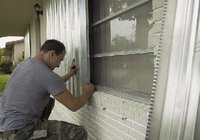 Low-income residents in 12 Florida counties are getting a little extra help this hurricane season to protect their homes from storm damage.
Low-income residents in 12 Florida counties are getting a little extra help this hurricane season to protect their homes from storm damage.
Under the state-funded My Safe Florida Home program, a total of 4,000 homes will be getting hurricane-rated storm shutters, stronger exterior doors, sturdier garage doors and improvements to roofs, all free of charge.
The preparedness program is an attempt by the Florida Legislature to alleviate high home insurance costs while allowing residents to strengthen their homes to better withstand hurricane damage.
“Everybody who lives in the state of Florida should know the importance of having shutters on their windows and just how much more secure you can be,” said 22-year-old Vanessa Hernandez, who was watching as her mother’s home in Broward County was being outfitted with the window coverings. “I feel more secure for them, too.”
She said the program would also help maintain the limited amount of affordable housing available in many areas. The program does not include mobile or manufactured homes, apartments, condominiums or businesses.
“It’s really critical that we save as much of our affordable housing inventory as we possibly can,” said Suzanne Yack, a staff member with Volunteer Florida Foundation. “We lost so much with Hurricane Wilma all across southern Florida. Nobody is building new affordable housing, so what we have left we’ve got to protect.”
Dale Hirsch, executive director of Volunteer Broward, one of two non-profit agencies running the program in Broward County, said the program’s $20 million total price tag for the 12 counties is a small amount to pay compared to the monetary damages a hurricane might cause.
“The building process is so expensive, the cost of fixing something is so expensive, it’s cheaper to mitigate it,” Hirsch said.
Several hundred homes have been strengthened so far with another 400 or so undergoing fortifications, according to the My Safe Florida Home website. Yack admitted that many of the homes enrolled so far in the program would not be ready for much of the 2007 Atlantic hurricane season, which officially began June 1. It ends Nov. 30.
The majority of homes being strengthened are in the south Florida counties of Miami-Dade, Broward, Palm Beach and Martin, Yack said.
The program began earlier this year. The non-profit agencies responsible for the programs publicized the project, then took applications from residents. In Broward County, 150 homeowners are scheduled to have work done this year; other Broward residents were on a waiting list.
“We had lines out the door,” said Sandy Lloyd, disaster specialist with Volunteer Broward. “There’s way more than 150 we could really help. Way more.”
Once a homeowner has been selected, the Volunteer Florida Foundation sends a certified inspector to the home to conduct a free inspection. The agencies in each county then work with the homeowner to schedule the work, arrange for necessary building permits and hire contractors. Two contractors have been hired in Broward County.
The local groups are asked to find matching funds as well as consider the use of volunteers to assist the contractors in order to leverage the project, Yack said. She said volunteers from faith-based groups, such as Mennonite Disaster Service which have construction experience, were especially welcome, as were people who can help find discounts on shutters, doors and roof bracing materials. “Right now, we have about 20 volunteers waiting for us to tell them what homes to go to,” Lloyd said.
“It’s not just about getting the funds,” Hirsch added. “It’s about layering the project with volunteers. Some actually have some construction background, although probably not a lot. But the ones that don’t can still do a great deal of work that doesn’t require hammering and nails.”
Each project is limited to a maximum of $2,500, eliminating the need for competitive bidding, Yack said. Homeowners can pay extra to upgrade the industrial-style hurricane shutters or have additional work done that may not be covered under the program, she said.
Yack said that the non-profit agencies were quickly learning about construction.
“They didn’t start as experts in shutters,” she said. “They will end this project as experts in shutters (and) be incredibly valuable.”
Yack said she expected the low-income program to continue for another year or two, with funding expected to double and the project expanded into other vulnerable counties.
“More money is going to be transferred into the low-income portion of the program because the need is so great,” she said, adding, “And because we’re doing a good job.”
Reproduced with permission from Disaster News Network www.disasternews.net
(c) 2007 Village Life Company




















Governor Crist vetoed hurricane help funding for manufactured homes at the eleventh hour and transferred said funds to high income homes. Now you praise that low incomers are getting the nod. High and low incomers 1, middle incomers Ã?. Crist does not care about middle incomers, throws a bone to the low incomers in an effort to be politically correct and caters to the high incomers. I am quite disappointed that you at Good News are ignorant about this and I’m gonna forward this Link and my reply to all my friends who were short changed.